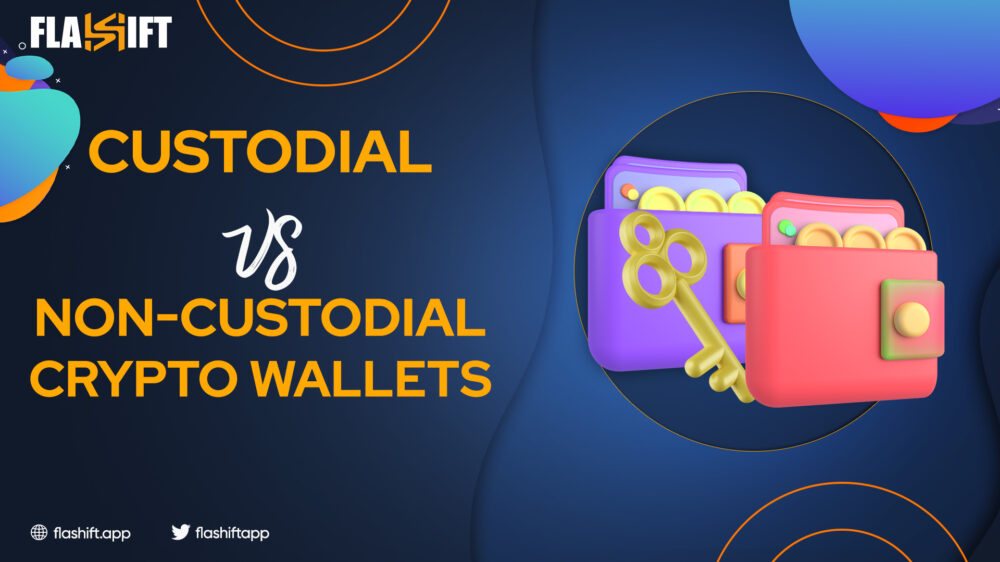A cryptocurrency wallet is either custodial or non-custodial that allows you to keep, retrieve, and communicate with cryptocurrencies such as Bitcoin and Ethereum.
Software-based wallets require installation on a user’s computer (desktop or smartphone), whereas hardware wallets are freestanding physical devices used for storing digital funds. Private keys—strings of digits and letters that operate as a very secret password—are stored in both hardware and software wallets.
Access to a private key allows a person to transmit crypto assets from a certain public address, rendering private key management critical.

A Custodial Wallet is one wherein private keys to the account are kept by a third party. In other words, the third party has complete authority on your cash, while you simply need to grant authorization to send or receive transactions. Non-custodial cryptocurrency wallets are a form of Blockchain wallet that allow you to act as a private bank. This implies that consumers have total control over their money as well as the private key associated with it.
Read more: What are Crypto wallets?
Hardware wallets, often known as “cold” wallets, are one of the most popular forms of non-custodial wallets because they keep private keys offline on a separate device that looks and feels like a USB drive. When you intend to send a cryptocurrency transaction, hardware wallets merely connect to the internet.
Custodial vs non-custodial wallets
When analyzing Custodial versus Non-Custodial wallets, the most important element to think about is who controls the private key.
In the situation of Custodial wallets, the private key is managed by a third party. In contrast, all blockchain custodian operations belong with users in the case of Non-Custodial wallets.
So, if you’d like to launch a wallet in which users may act as their own bank, consider developing non-Custodial blockchain wallets (also known as self-custodial wallets).
When analyzing Custodial and Non-Custodial crypto wallets, another factor to think about is transaction type.
In Non-Custodial, the trade appears on the chain in real time. However, this is not the case with Custodial wallet.
All sensitive customer data is maintained in hot and cold store in custodial online crypto wallets, which are frequently compromised by data attackers. As a result, until the responsible party applies strict security regulations the security level in custodial settings is poor.
In the situation of a non-custodial crypto wallet instance, the entire information stays with the consumers. This decreases the possibility of data theft, unless the person using it shares the information with another person or their device is lost. You have to initially log onto your Custodial wallet and complete an inquiry to centralized authority to acquire permission to access the cash and related data. This necessitates the use of internet access.
Non-Custodial wallets, on the contrary, are exempt from this need. As a consequence, Non-Custodial wallets are a preferable choice for experiencing entire services related to blockchain development right now.

Examples of custodial crypto wallets:
- Binance
- BitMex
- BitGo
- Blockchain.com
- FreeWallet
Examples of non-custodial crypto wallets:
- Electrum
- Zengo
- Exodus
- Wasabi
- TREZOR One
- Ledger Nano X
Pros & cons of custodial wallets
One of the most significant advantages of a Custodial wallet is that, as opposed to other types of wallets, it does not charge fees for transactions. It allows clients to conduct transactions for free inside the ecosystem.
Your custodial wallet is managed by a third party. As a result, regardless of whether you misplace your private key or forget the memorized phrase, you may easily restore access to your wallet and its stored assets.
Another advantage of custodial wallets is that their services for backup are provided by the centralized authority that administers your wallet. This facilitates the undoing of any transaction or the restoration of a prior version.The most significant downside of using Custodial bitcoin solutions is the fact that you lack control over your digital currency account.
The money you have and associated operations are completely within the custodian’s control. They have the authority to act on the cash, including restricting the amount kept. When it comes to custodial vs. non-custodial trading, the first time you acquire cryptocurrency, it will almost certainly end up in a custodial exchange web crypto wallet.
Last but not least, an Internet connection is required for signing into Custodial wallets or performing any transaction.
Pros & cons of non-custodial wallets
The primary reason why Non-Custodials are gaining popularity is that they provide consumers direct access to their monies. Users do not need to rely on a third party to handle their funds or undertake any associated activity. Because you are responsible for all aspects of your online Crypto wallet and its cash, the chance of data breach is substantially smaller. Unlike top Custodial wallets, these wallets do not require third-party confirmation for every transaction. This simplifies the entire procedure and allows for immediate withdrawals.
Because non-custodial money is originally transferred to an exchange, it will be difficult to trade fast. Being responsible for your own safety entails a great deal of duty. Even little errors might result in thievery, elimination, or unintended repercussions.
Furthermore, User Interfaces are provided in an increasingly difficult-to-understand manner. If you misplace your key and seed word, there will be no one to assist you in recovering your wallet or data. The loss of a private key or alphanumeric seed might result in the user losing access to their wallet, with no means of backup or recovery options.






